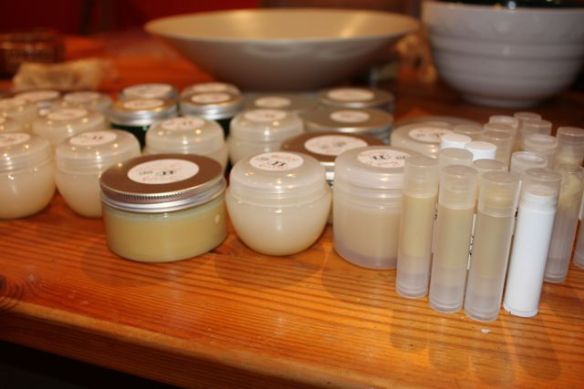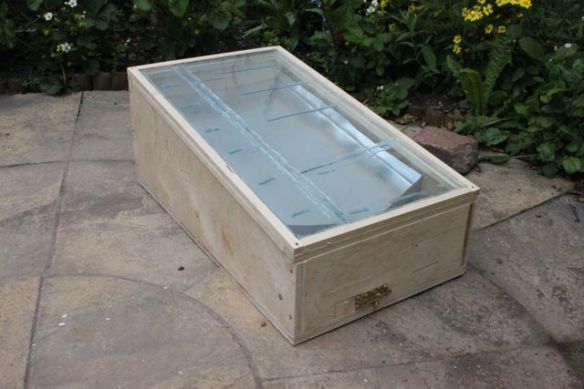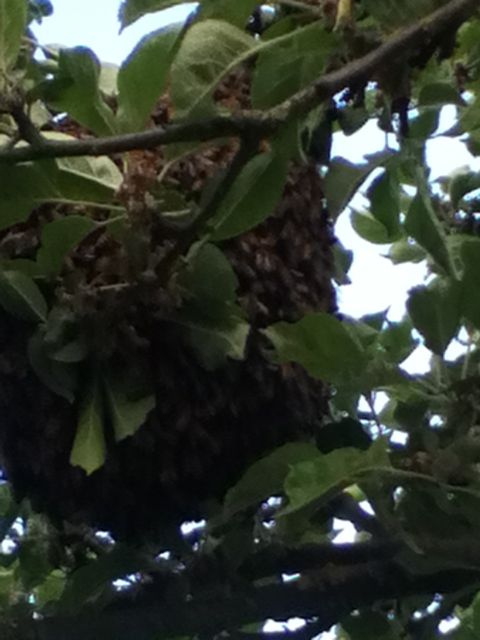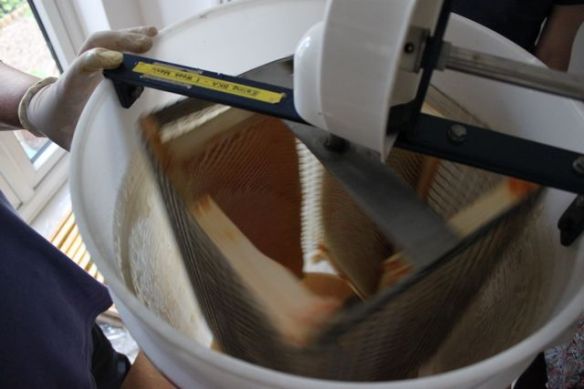Having confirmed in March 2013 what we had suspected through the winter – that our colony had died, we now had a hive full of frames of wax to deal with.
I like an excuse to make things. And having successfully, but messily, extracted wax from frames using the ‘tights’ method previously (pair of old tights in an old saucepan with some water, old frames – without the wood – going into the tights, wax coming out into the water and debris getting held in the tights), I decided there had to be a less intensive way of recovering the wax.
And so it was time to build a solar wax extractor. Essentially it’s a double-glazed box that will heat up in the sun, with a metal tray that the whole frame sits on, and the wax will run down to a collecting tray in the bottom. Beeswax melts at between 62 and 64 degrees celsius, so this is the temperature that you need the inside of the box to get up to.
The double glazed (hinged) lid was built from some single glazed glass windows down at the allotment, cleaned up, cut to size and sealed into the frame with silicon sealant. Several beads of silicon sealant placed on the first sheet of glass keep an air gap between the two. The join that you can see is just on the top panel, and simply because I hadn’t quite got the hang of the glass cutter and managed to break the glass in the wrong place when I cut it.
There are three drainage holes in the bottom of the glazing frame, which you can see in the third picture below. This allows any moisture between the two panes to drain out – if it were totally sealed there is a risk the air in between would expand when it heated up and potentially crack the glass.
The metal sheet is an aluminium sheet, recycled from a lithographic printer. If you know where to get them, you can get them for free, but I just got it via the internet for pretty cheap. The metal attracts the suns rays, helping to heat up the box. While you could have a single glazed lid, the double glazed lid limits the extent to which the heat is lost again. In an English climate this is useful. If you live somewhere where you get more sun, single glazed would be perfectly adequate.
On a relatively shallow slope, the wax in the frame will melt and run down into the collecting container, leaving any debris behind. On a brood frame, the debris includes the papery cases in the cells, left behind by the bees as they pupated – so much so that it often looks like the wax hasn’t actually melted out, as the frame still looks like it is intact.
Some people put a mesh screen at the bottom of the tray, to filter out any further debris, but I’ve found that with a reasonably shallow slope you don’t get that much other than wax going through into the collecting container – and you can always run it through again to clean it up further.
I made this solar melter able to accommodate a single brood frame, to limit the space I’d need to store it. Of course this does mean it can take a while to deal with many frames. It obviously needs sun to make it work, and this is not always abundant in England! It can only realistically be used in summer, but on a decent day near to the solstice (and with some rotation through the day to keep up with the sun), it can melt a couple of frames, maybe 3.
The latch that you see on the front of the box is holding in a piece of wood that can be removed. There is a similar one beside it (but currently without a latch), and one at the other end of the box at the top of the back panel. When melting wax, these are kept in place, as you want it to be bee-tight, and also you need to keep the heat in. In fact, I could probably do with improving the seal around these pieces to reduce heat loss when melting wax.
However, when these pieces are taken out, and with the replacement of the wax melting tray with a mesh tray, the idea is that it can be converted into a solar drier to dry fruit. The principle is that the holes (one at the top back and two at the bottom front) will encourage flow of air through the box as it heats up – hot air out through the top back and cool air drawn in through the bottom front, and this will dehydrate fruit slices or leathers. I have yet to try it – something for next summer.
Having melted the wax out, we were left with the wooden frames. As some of these were covered in bee poo, and indication that our colony had probably had some nosema, it was best simply to replace these than try and reuse them. They burnt well in our clay pizza oven at the community garden on one of our pizza days. The wax and honey residues definitely helped them to catch alight!
We use the papery cases left behind from the cells in our smoker – they burn reasonably well with the little bit of wax that is left on them. It is said that the smoke from ‘slum gum’, as it is called, calms the bees. I’m not sure I notice any difference between that and any other lighter fuel we use.

And so that left us with the wax, which we turned into a variety of lip balms and body butter. 

 This is some of our honey soap that we tried – it worked very well, and has produced a soap that makes a nice lather. It was made in a mould imprinted with honey comb and bees. There isn’t any wax in this, but there is some honey. Beside it are some bottles of propolis tincture that Angela made by dissolving the propolis that we remove from the hive in 100% alcohol. It makes a gargle for sore throats and coughs, and can also be used in cosmetics.
This is some of our honey soap that we tried – it worked very well, and has produced a soap that makes a nice lather. It was made in a mould imprinted with honey comb and bees. There isn’t any wax in this, but there is some honey. Beside it are some bottles of propolis tincture that Angela made by dissolving the propolis that we remove from the hive in 100% alcohol. It makes a gargle for sore throats and coughs, and can also be used in cosmetics.
Most people think of a hive as just a honey producer, but there’s plenty of other products from the hive that can be used rather than just thrown away.



















































